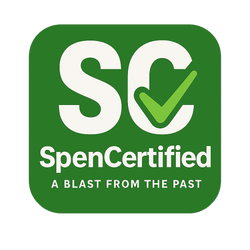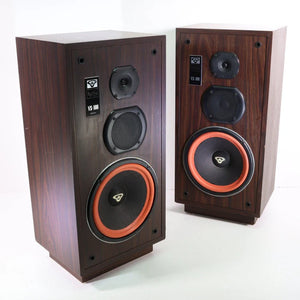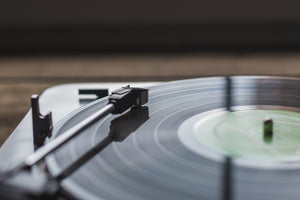We are unable to reply to comments, so please message us directly if you have a specific question regarding products, shipping costs, etc. Our office number is (480) 207-1511. Our email is hello@spencertified.com. You can also message us on Facebook. Commonly asked questions and answers can be found on our FAQs page here.

BELT-DRIVE VS DIRECT-DRIVE TURNTABLES: WHAT’S THE DIFFERENCE?
THESE PROS AND CONS WILL HELP DETERMINE WHICH TYPE IS BEST FOR YOU
With the resurgence of vinyl, there are a lot of newbies flocking to the scene of vintage audio and just as many oldies looking to rekindle their love with a record player or three. It’s a big wide world of vinyl out there, and one of the first choices you’ll stumble upon is whether to invest in a belt-drive turntable or a direct-drive turntable. If you were to ask anyone experienced with record players which type to choose and why, you'd get a different answer every time.
Each turntable brings something unique to the platter, and what’s best for one person may not be best for another. So to help you decide, let’s dig into it and see the differences, pros, and cons that lie between the grooves.
WHAT’S THE DIFFERENCE?
Belt-Drive: This refers to turntables that spin using a belt. The motor is offset from the platter, and it’s connected using a rubber belt attached to a motor pulley. The belt acts like a shock absorber, which dissipates the motor’s vibrations, allowing a natural, clear sound.

Direct-Drive: This refers to turntables that spin using gears. A direct drive motor is located under the turntable platter, and it’s directly connected to the spindle. Then when the motor is on, it causes the platter to spin around at a stable and consistent speed.

So, essentially, the difference comes down to how the motor moves the platter: using a belt or using gears.
WHY CHOOSE A BELT-DRIVE TURNTABLE?

The largest argument made in favor of belt drives tends to be regarding their sound. It’s not necessarily better quality, but these turntables do have an innate edge in reducing vibration and noise thanks to their elastic belt; this rubber belt absorbs unwanted vibrations, offering a certain purity of sound. Plus, one con of direct-drive turntables is that motor noise may be heard when it’s transmitted to the stylus depending on its construction and quality. Belt-drive turntables don’t have this issue as it decouples the motor from the platter.
For many, this creates a more authentic sound, resulting in an emotional experience that makes you feel closer to your vinyl. This type of feeling is at the heart of music listening for a lot of vintage aficionados and audio enthusiasts, which is why many choose belt-drive turntables, especially for at-home listening.
Belt-drive turntables also tend to offer a smoother, gentler ride for your records. With features like anti-skating, belt drives safeguard your vinyl. This may be a major benefit if you have a larger collection or one that you want to preserve for years to come.
WHY CHOOSE A DIRECT-DRIVE TURNTABLE?

One of the greatest pros of direct drives is the speed stability. The low to no wow and flutter, which ensures stellar audio quality, is a great benefit for many audiophiles. Since the motor and platter are connected, you get a continuously consistent speed and an incredibly stable performance.
With direct-drive turntables, you also get variable pitch control and high torque. While belt drives are more of a ‘slow-and-steady wins the race’ type of machine, direct drives speed up quickly and keep on spinning until you tell it to stop. They’re also reliable. One con of belt-drive turntables is that you will need to replace their belt eventually; direct-drive turntables don’t have that problem.
We would also be remiss not to mention the benefit that became the basis for DJs: versatility. Thanks to the high-torque motor, variable pitch control, and the ability to disengage the motor, DJ artists can use this turntable like an instrument, manually moving the record back and forth for “scratching.” A pretty cool way to match beats for non-stop dancing.
SUMMARY
So, which is better? In a nutshell, if you’re a vinyl enthusiast who really wants to delve into the nostalgic feel of turntables and cherish every musical detail, you’ll want a belt-drive. If you’re looking for speed and stability (or you’re wanting to try scratching or DJing), we recommend a direct-drive. As with all things, it comes down to personal preference. No matter which you choose, the wonderful world of vinyl will not disappoint.
Also keep in mind that choosing between belt-drives and direct-drives is just the tip of the iceberg! Turntable quality depends on several different factors, and even after you narrow down the type of turntable you want, there are still enough designs, features, and functions to drown in if you don’t learn how to swim first - but never fear! That’s why we created the Turntable Jargon reference article to parse down what you need to know in an easy-to-follow list of keywords. You can find it here.
And if you’re interested in owning or browsing belt-drive and direct-drive turntables, you can check out the wide selection we have up for sale here. Thanks for reading! Have a great day.



Leave a comment